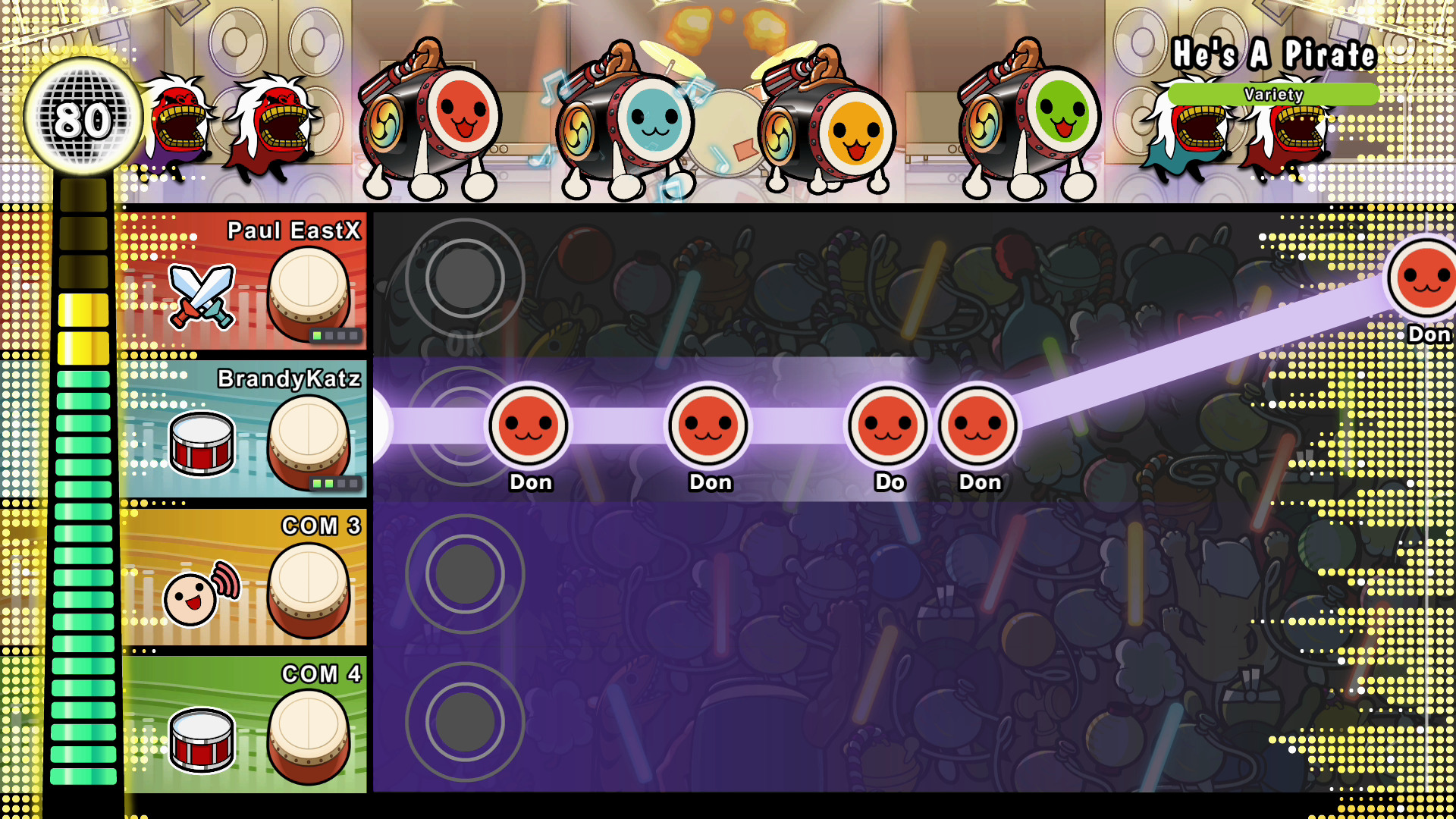Bandai Namco’s Taiko no Tatsujin series of drum-based rhythm games has appeared on every major console this generation, but none more than Nintendo Switch. Taiko no Tatsujin: Rhythm Festival marks the franchise’s fourth Switch entry. This installment kicks things up a notch with the new 4-player co-op DON-Chan Band mode, the addictive Great Drum Toy War mode, a sizeable story that binds everything together, and, of course, the traditional Taiko mode. While music fans will get countless hours of enjoyment across the various modes, we’re especially psyched for the co-op.
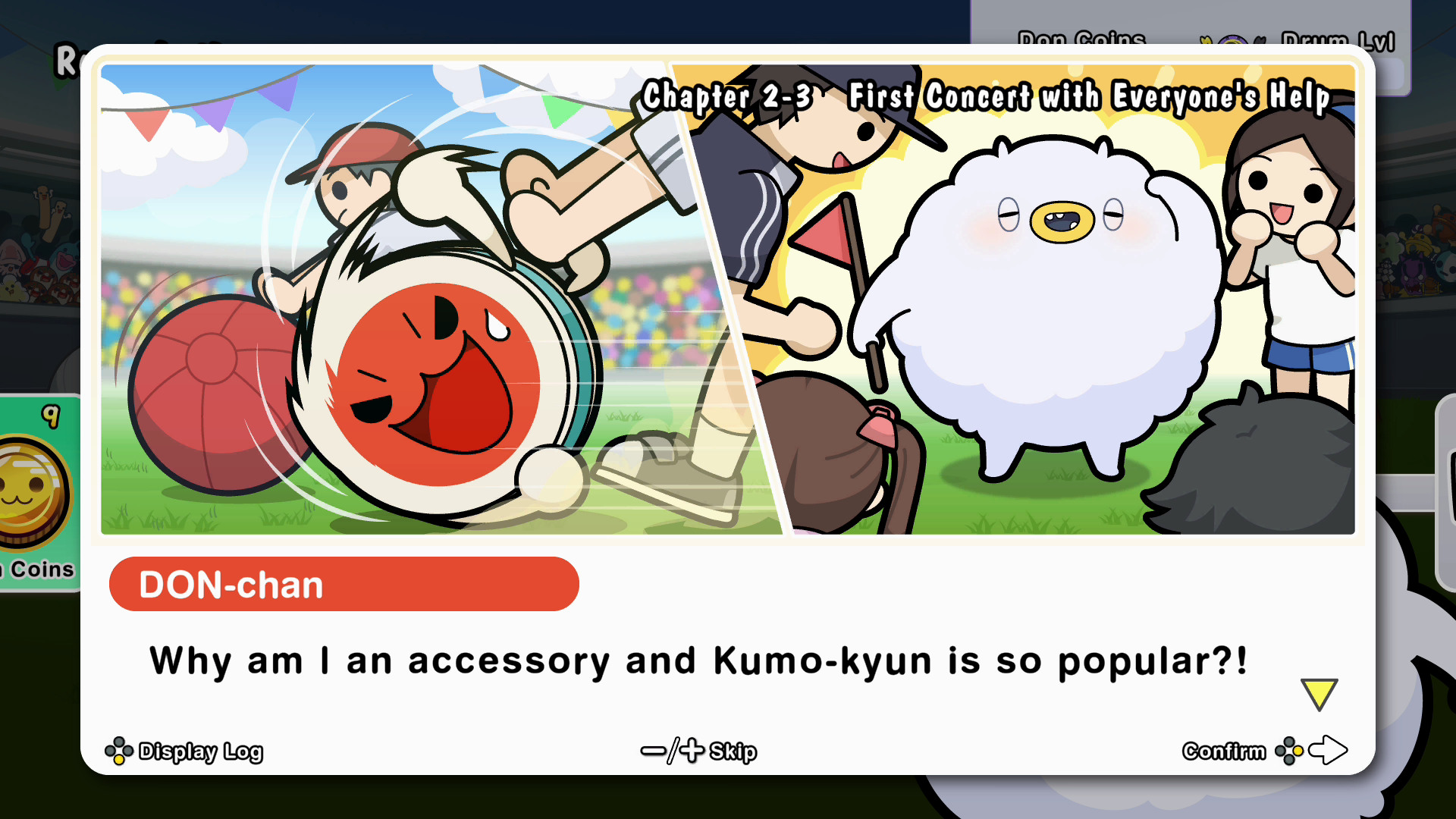
Rhythm Festival begins with a cinematic depicting the arrival of DON-Chan, the series’ protagonist, in Omiko City. There, he quickly befriends a shapeshifting creature known as Kumo-kyun. The two will team up to engage in numerous performances and activities throughout the city. The story comes to life via a combination of text-based dialog and character portraits, much as you’d find in a visual novel or classic RPG. Expect a simplistic narrative driven by cuteness and cheerfulness, a perfect fit for a music game starring anthropomorphic drums.
From the main Omiko City menu, players can visit the Thunder Shrine to play Taiko Mode, Taiko Land to play party games, Dondoko Town for online play, “My Room” for customization (including some Nintendo-themed outfits), and the Store that sells numerous customization items. Whichever modes you play, you’ll earn Don Coins for shopping and Drum Level experience. Increasing the drum level will unlock new rewards as well as progress the overall story. It’s a solid, enjoyable progression system.
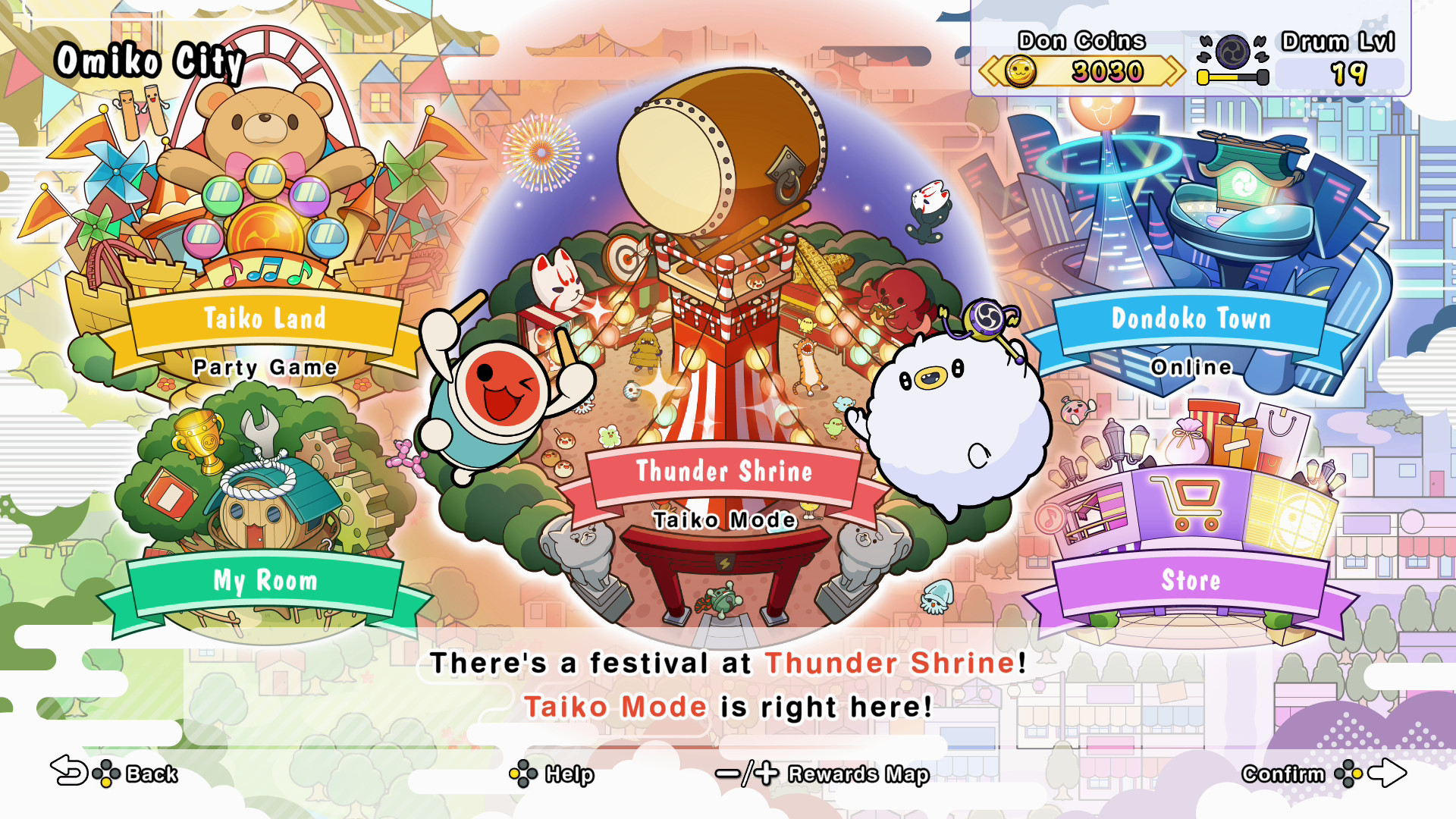
Taiko Mode offers the traditional series experience. One or two players select a song, a difficulty, and then do their best to play along to the music. A series of red and blue note symbols scrolls by from the right; the goal is to hit the corresponding button when the notes hit the target spot on the left. Large notes can be hit with two buttons for extra points, yellow streaks represent drum rolls, and balloon notes can be popped by rapidly hitting a button. It’s simple, but faster songs and higher difficulties add loads of challenge. The new Improvement Support feature lets players train on specific portions of a song, which should help.
The more notes that players successfully hit without missing, the higher the soul meter above the playing field fills. Increase the meter to yellow and you’ll pass the song, earning a decent chunk of coins along the way. Failing to reach the yellow will result in a loss and only a small number of coins being earned. Achieving a “full combo” by hitting every single note will net the highest rating and payout. As the soul meter fills, the characters and visual effects in the background get crazier and more frantic – a big part of the fun. Taiko Mode allows two players to play their own note fields simultaneously in a competitive fashion, though it doesn’t feel competitive except when playing online.

The Great Drum Toy War is Rhythm Festival’s addictive new mode. In it, players assemble a toybox (deck) full of cute taiko characters, all of whom grant different effects during battle. You then equip the box and play songs against an AI character or another player. These battles work like normal Taiko songs crossed with tug of war. As players hit notes well, a new meter fills up that eventually performs an attack from the toy box. Attacks in this mode create fake notes, scramble the playing field, reverse the note colors, and more. This makes for chaotic, dynamic battles. When the song ends, whichever player summoned more characters from their toy box is declared the winner.
The single-player portion of the Great Drum Toy War offers 21 missions, all with their own stories focused around toy battling. Each mission challenges the hero to face off against a different Taiko character while trying to complete three optional objectives. The objectives tend to involve equipping a specific toy or performing a certain toy’s attack during the match. These goals add replay value, but they’re hampered by the toy box component’s clumsy user interface. Between missions, you have to back out to the top Great Drum Toy War menu in order to access the toy box editor, a slow and clunky process. It’s tough to see and know the effects of your toy box units before a match, which further necessitates more slow trips to the top menu. The whole process adds a sizable hassle to what should be a quick pick-up-and-play experience.

Thankfully, the new DON-Chan Band mode is more intuitive. 1-4 local players can form a band and either complete missions or just play songs of their choosing. All of the 20 missions have their own pre- and post-song cinematics, so DON-Chan Band really is a cooperative story mode. Each of the four band members play a specific instrument or role during the song, with AI bandmates filling any empty spots. DON-Chan Band can’t be played with online players, unlike the Taiko and Great Drum Toy War modes.
In DON-Chan Band, the team shares one giant playing field. Each player has their own lane to worry about, but there are new cooperative mechanics. Sometimes all four members need to hit a note at the same time; other times, everyone needs to get the notes in a sequence correct. These new mechanics fit the band theme perfectly well, though a poor player can really tank the band’s performance and cause everyone to fail the song. A handicap option for individual players would help. Also, the total number of playable songs in DON-Chan Band tops out at 20, which is a bit skimpy. Presumably, the limited quantity is due to songs needing new, unique 4-player note charts just for the one mode.
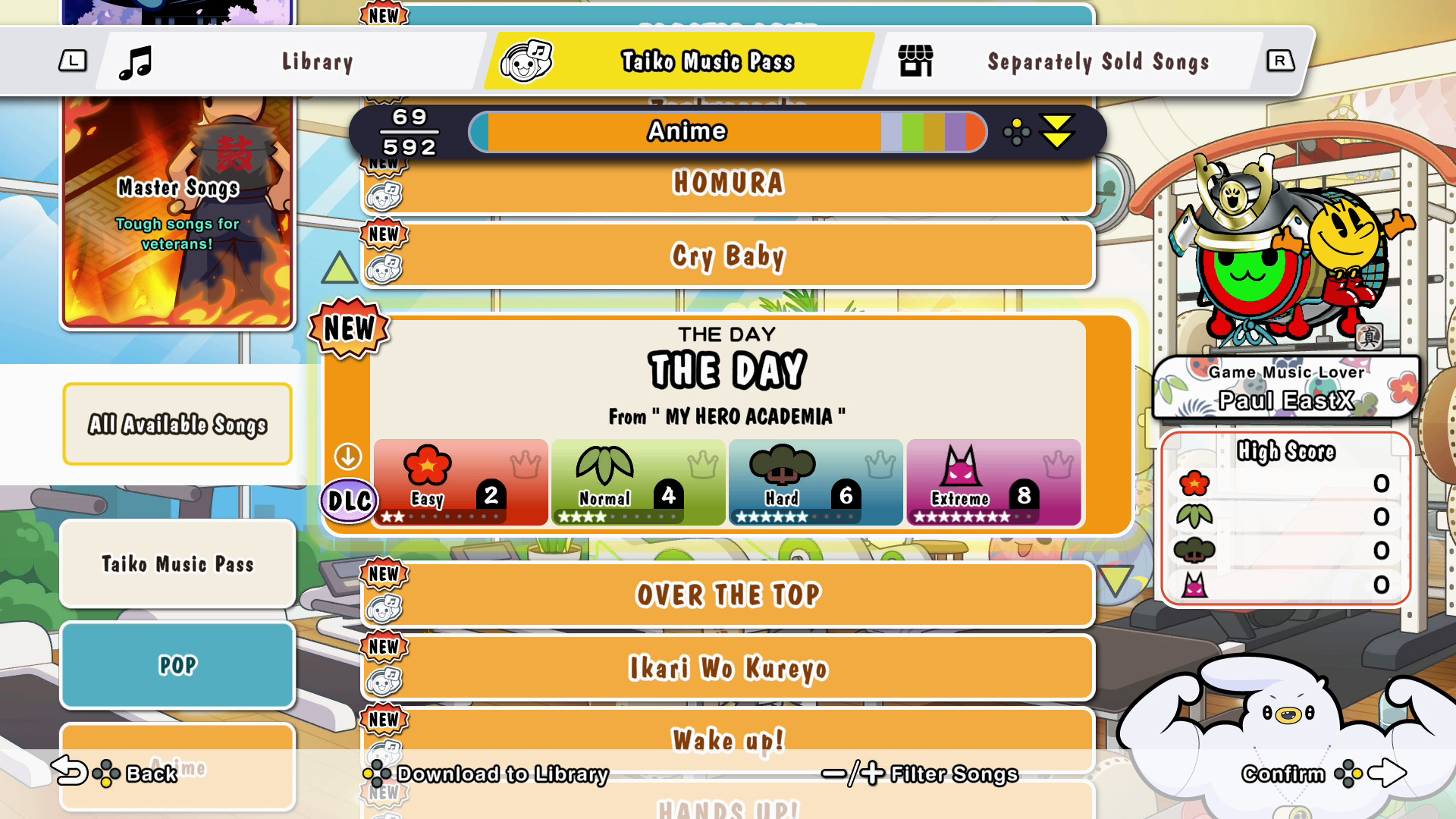
Taiko Music Pass interface
A music game is only as good as its song library. Rhythm Festival features a typical Japanese music-heavy soundtrack, with 76 songs included from 7 categories: Pop, Anime, Vocaloid, Variety, Classical, Game Music, and Namco Original. Highlights include tunes from Nintendo’s Super Mario Bros, Legend of Zelda, and Kirby, as well as the Sailor Moon theme song. DLC packs are available with songs from Dragon Ball, Hatsune Miku, One Piece, and more. Additionally, Rhythm Festival offers the optional subscription-based Taiko Music Pass. For either $5 monthly or $10 every 90 days, players can access an ever-growing library of over 500 songs. Hey, if you want the game to last practically forever, it’s an option!
Rhythm Festival plays well with or without a drum peripheral. Drums add motion and extra sound to the experience, but it’s probably easier to hit note prompts consistently with buttons. If you do buy a drum, don’t cheap out with third-party drums. Get the official Hori-brand drum for Switch. I use the official PlayStation drum (no longer in production) in combination with the Brook Wingman NS accessory to get the same authentic experience, and it’s a joy.
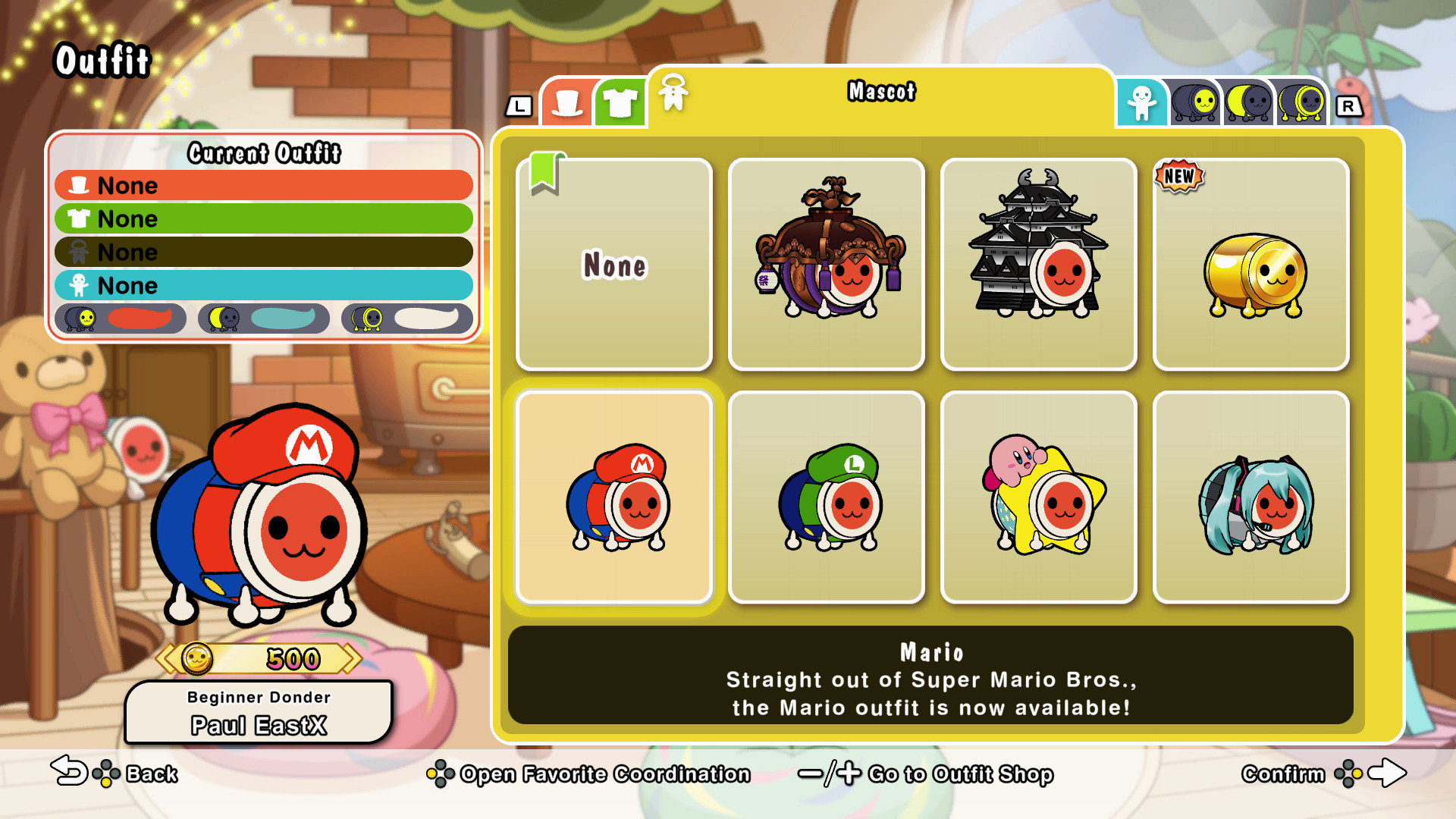
Barebones Taiko games (such as Taiko no Tatsujin: The Drum Master for Xbox) are plenty of fun even without story modes. Still, the delightful new modes and story that ties them together make Taiko no Tatsujin: Rhythm Festival one of the very best games in the series. The 4-player DON-Chan Band mode in particular adds a welcome cooperative element absent from most Taiko games. It’s a shame that the Great Drum Toy War mode‘s menus are so unwieldy, but everything else about Rhythm Festival is so polished, it hardly matters. Music game fans won’t want to miss out on DON-Chan and friends’ grandest adventure yet!
Taiko no Tatsujin: Rhythm Festival sells for $49.99 digitally and physically. The $54.99 digital Deluxe Edition bundles the game with a 90-day Taiko Music Pass – a $5 savings over buying them separately. The official Taiko no Tatsujin drum controller costs ~$82 on Amazon.
A Nintendo Switch code was provided by the publisher for review.
Verdict
Co-Op Score
Overall
The Co-Op Experience: The new DON-chan Band mode allows up to four players to play a co-op session together. Everyone drums the same song but each with their own line. The difficulty of the song can also be set for each player individually. Taiko mode also returns for two players to drum together.
Co-Optimus game reviews focus on the cooperative experience of a game, our final score graphic represents this experience along with an average score for the game overall. For an explanation of our scores please check our Review Score Explanation Guide.
